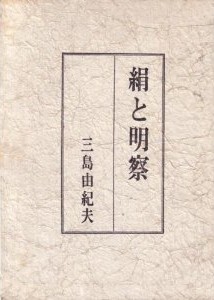You can help expand this article with text translated from the corresponding article in Japanese. (July 2020) Click for important translation instructions.
|
 First edition (publ. Kodansha) First edition (publ. Kodansha) | |
| Author | Yukio Mishima |
|---|---|
| Original title | 絹と明察 (Kinu to meisatsu) |
| Translator | Hiroaki Sato |
| Language | Japanese |
| Published | January–October 1964 in Gunzo |
| Publisher | Kodansha |
| Publication date | 15 October 1964 |
| Publication place | Japan |
| Published in English | 1998 |
| Media type | Print (hardcover) |
| Pages | 299 |
| OCLC | 672529106 |
| Dewey Decimal | 895.6/35 |
| LC Class | PL833.I7 K55213 1998 |
Silk and Insight (Japanese: 絹と明察, Hepburn: Kinu to meisatsu) is a 1964 novel by the Japanese writer Yukio Mishima. The subject of the novel is taken from an actual strike in Japan in 1954 at Omi Kenshi, a silk thread and fabric manufacturer, which lasted for 106 days. The novel was first serialised in the monthly magazine Gunzo between January–October 1964. It was published in hardcover format by Kodansha on 15 October 1964. It was translated into English in 1998 by Hiroaki Sato.
Although a commercial failure, the novel was awarded the Mainichi Prize from Mainichi Shimbun.
Plot
Komazawa Zenjiro runs his silk factory like a family and feels like a "father" to his workers. Through various intrigues initiated by the trade unionist Okano, the company's workers are instigated into a strike, which escalates to such an extent that Komazawa dies of a stroke. Okano takes over his position, but comes to understand the philosophy of his predecessor.
Publication
Silk and Insight was first serialised ten times in the monthly magazine Gunzo between January 1964 and October 1964. It was published in hardcover format by Kodansha on 15 October 1964. It was published in paperback by Kodansha Bunko on 1 July 1971.
The novel was a commercial failure, with only 18,000 copies published. In comparison, Mishima's novel Kyōko no Ie (1959) sold 150,000 copies in its first month.
Translation
Mishima originally intended for the novel to be translated into English by John Nathan, who Mishima first met in 1963. In 1965, Nathan translated Mishima's The Sailor Who Fell from Grace with the Sea. Impressed by Nathan's translation, Mishima requested Nathan sign on as his translator and help Mishima in his quest in being awarded the Nobel Prize for Literature. Nathan was more interested in translating the work of Kenzaburō Ōe. Nathan initially agreed to translate Silk and Insight, but was unimpressed with it upon his first reading. He ultimately refused to translate the novel, opting instead to translate Kenzaburō Ōe's A Personal Matter. Mishima, who was considered an "arch-rival" of Ōe, abruptly severed ties with Nathan afterwards.
Silk and Insight was later translated into English in 1998 by Hiroaki Sato and edited by Frank Gibney as the seventh volume in The Library of Japan series, produced by the Pacific Basin Institute at Pomona College.
Reception
The novel was awarded the Mainichi Prize from Mainichi Shimbun.
Notes
- "絹と明察". CiNii. Retrieved 31 July 2020.
- Sato, Hiroaki. "Introduction" Silk and Insight. M.E. Sharp: 1998. p. xv.
- ^ 佐藤秀明; 三島由紀夫; 井上隆史; 山中剛史 (August 2005). 決定版三島由紀夫全集. 新潮社. pp. 433–437. ISBN 978-4-10-642582-0.
- ^ 佐藤秀明; 三島由紀夫; 井上隆史; 山中剛史 (August 2005). 決定版三島由紀夫全集. 新潮社. pp. 540–561. ISBN 978-4-10-642582-0.
- ^ Damian Flanagan (15 August 2014). Yukio Mishima. Reaktion Books. p. 180. ISBN 978-1-78023-419-9.
- Marshall, Colin (26 April 2010). "Unceasing fascination with Japan, immersion in literary culture and the pleasures and sorrows of the "thrown" life: Colin Marshall talks to writer, translator, filmmaker and teacher John Nathan". 3 Quarks Daily. Retrieved 30 July 2020.
- "Literature critic John Nathan dissects Japan's Nobel Prize laureates | The Japan Times". The Japan Times. Retrieved 18 May 2018.
- Morris, Mark (25 October 1998). "Raw Material". The New York Times. Retrieved 14 April 2020.
External links
This article about a 1960s novel is a stub. You can help Misplaced Pages by expanding it. See guidelines for writing about novels. Further suggestions might be found on the article's talk page. |
- Culture articles needing translation from Japanese Misplaced Pages
- 1964 Japanese novels
- 20th-century Japanese novels
- Fiction set in 1954
- Japanese-language novels
- Novels by Yukio Mishima
- Novels set in Japan
- Kodansha books
- Works originally published in Gunzo (magazine)
- Novels set in factories
- Works about the labor movement
- 1960s novel stubs